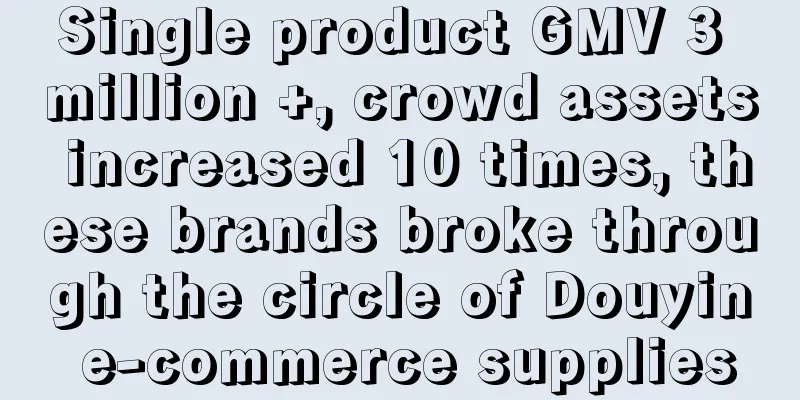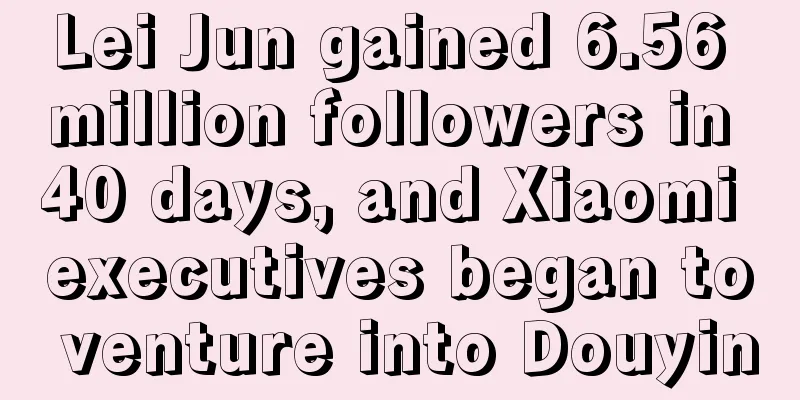In the period of consumption downturn, we should pursue "good failure" rather than "reducing costs and increasing efficiency"

In this business environment where consumption is fading, anxiety is the main theme of entrepreneurs. Looking at how some successful companies survived, or even grew against the trend, may help us find some "certainty". Today, let me share the experience of Uniqlo. During the Great Depression in Japan, Uniqlo's sales increased 160 times in 20 years, and its profits increased 1,500 times! Some people may say: Uniqlo's business in China is also declining, so it is not worth studying. Indeed, Uniqlo just released its third quarter financial report, with both revenue and profit falling. Uniqlo's head of China even announced that it would adjust its store opening strategy: from adding 50-80 stores per year to reducing or renovating 50 stores per year in the next three years... Why do I still want to study Uniqlo under such circumstances? If you really know the history of Uniqlo, you will find that most of Uniqlo's businesses in the past have failed, and only a few have succeeded. Its founder Tadashi Yanai has a very classic saying: "Business is the constant challenge and attempt to find out what can be effective when things are not going well." Yanai's Uniqlo rose against the trend during the economic downturn in Japan and reached its current status. The key is that he himself has a "failure experience". Therefore, I have always had a hope in my heart: Uniqlo, which is used to repeated failures, may be able to take another step forward. Today, we will analyze how a company can achieve sustained growth during a period of consumer downturn through Uniqlo and Tadashi Yanai. The key point is: when the consumer environment is sluggish, UNIQLO's core strategy is not to reduce costs and increase efficiency! On the contrary, UNIQLO outperformed the market through constant efforts and achieved the myth of counter-trend growth in the early years. 1. Business is about constantly trying to figure out what will work when things aren’t going well.When recalling the past, Tadashi Yanai often said: "Most of the things I did were failures, but it was precisely because of these failures that I achieved my success today." One year, Tadashi Yanai opened a design company in New York to collect fashion information. He then took the fashion information to a company in Osaka to design products, which were eventually produced in a factory overseas, thus forming a "three-in-one" business model that integrates R&D and sales. But under this model, almost all the products they launched failed, and none of them were best-sellers. First of all, let me explain why we have to adopt such a model. The clothing industry is different from other industries. It is more like a "futures business". In other words, clothing is popular for a period of time, but once that period has passed, it will be unsalable. If clothing wants to sell well, companies must be keenly aware of fashion information. Although Uniqlo makes so-called de-fashioned basic styles, it cannot avoid the industry attributes, which is why Yanai is opening a company in New York. Later, Tadashi Yanai summarized the reasons for the failure of this model, which was mainly due to the poor information communication between New York, Osaka and overseas manufacturers, which led to a disconnect between product planning and sales. For example, New York thinks a certain design will be popular, so it gives it to a factory to produce. However, the product does not perform well after it is launched on the market, but this data is not fed back to the company in New York in a timely manner. Next time, there will definitely be no adjustments to this market data. This is a failure of information communication. This failure also led Yanai Tadashi to a conclusion that product planning must be linked with sales in some way. In his early years, Yanai Tadashi had an idea. He wanted to sell special casual clothes for children and the elderly, so he opened two types of stores with different brands. Later, he found that this was a completely anti-consumerism business decision. Because from the customer's point of view, he used to go to one Uniqlo to buy clothes for the whole family, but now he has to go to three stores to buy everything. In the end, Yanai Tadashi had to merge several brands into one Uniqlo. Back then, Uniqlo also experienced failure in recruitment. In order to develop rapidly in the early years, Yanai Tadashi recruited a group of senior talents to the company. He published a recruitment advertisement in the newspaper, saying that he was looking for directors and presidents, but all the applicants were people who wanted to live a comfortable life and just wanted to be officials. However, the working style of Uniqlo is that the leader must rush to the front line to experience the market. Later, Uniqlo changed its recruitment strategy. More than half of its directors and executive directors were recommended by acquaintances, and it no longer conducted open recruitment. Tadashi Yanai once said that failure in actual combat is better than failure on paper. Yanai Tadashi said that he had met many people with very good brains, but these people often stayed at the planning stage and never put them into practice. But if you don't practice, you won't know whether this thing is right or wrong. Therefore, most of Yanai Tadashi's strategies are obtained from practice, not planning. Tadashi Yanai attaches great importance to the quality of failure. He believes that not all failures are good, but entrepreneurs must fail. Yanai Tadashi has two crucial principles on how to deal with failure. The first principle is to have the courage to admit failure and stop loss at the first opportunity. This sounds very simple, but it is difficult for most people to realize what a real failure is. Because the more confident a person is in himself, the more he thinks his plans and ideas are feasible. When his plan continues to encounter twists and turns, he will always think that there is room for reversal. This kind of behavior of not correcting in time and being stubborn will often drag himself into the quagmire. This is Yanai’s first attitude towards failure. Once any decision fails, he will turn around, make changes, and review the situation immediately, instead of blaming himself or others. A quick recovery is more important than anything else. The second principle is that as long as the failure is not fatal, it will definitely give birth to the seeds of success, and lessons for the next success should be learned from the failure. The earliest Uniqlo stores were opened in the suburbs. They were very successful over the years and could be said to have reached a certain scale. But the problem is that even after the sales scale has increased, the brand's reputation has not improved. When people mention Uniqlo, they either have bought its products but don't know the brand well, or they think it is a low-quality brand. Therefore, Yanai Tadashi decided to open a store in Harajuku, Tokyo. But the timing was not right before. As a gathering place for big brands, the rent in Harajuku is very expensive, and Uniqlo has always been known for its low prices, so it cannot afford such a high rent. Later, when Japan experienced the bursting of its economic bubble, the rent in Harajuku suddenly became cheaper and many clothing stores went out of business. Only then did Yanai Tadashi wait for the opportunity to open a store. But Uniqlo's Harajuku store is also doomed to close. The so-called Tokyo Harajuku Store No. 1 that everyone sees is actually its Store No. 2. There are two particularly important reasons why the first Harajuku store did not open: the first reason is that Uniqlo opened an urban store but used the model of a suburban store. When doing marketing, suburban stores will print all the products on flyers and hold promotions on weekends. For example, a pair of pants that sells for 2,000 yen on weekdays will be sold at a promotional price of 1,500 yen on weekends. They will also determine the number of flyers based on the number of potential customers around the suburban store and calculate how many flyers are appropriate for them to distribute. However, this model is completely inapplicable to urban stores. First of all, handing out flyers is ineffective. The customers in Harajuku are not the residents in the surrounding area, but the trendy people in Japan, and flyers cannot be distributed to all of them. If you want to advertise in Harajuku, Tokyo, you must do it in the big media and do it in a bombarding manner to reach consumers. Secondly, in an area like Harajuku where there are many stores, many products, and a lot of competition, printing all the products on flyers and sending them out in large quantities will make customers wonder what the characteristics of your store are. You must focus all your energy on a trump card product or service to make it work. Finally, you can’t just do promotional advertising. Because in Harajuku, consumers not only look at the price, but also the quality of the goods. When you keep doing promotions, consumers will think that you are no different from a discount store, and will think, “I’m shopping at a discount store in Harajuku, so why not go to a suburban store?” After realizing these problems, Tadashi Yanai immediately adjusted his business strategy. The second reason is that ordinary basic clothing cannot attract customers in Harajuku, Tokyo, where there are many shops. The positioning of Uniqlo's basic styles is the result of Yanai Tadashi's feedback from actual demand through the process of opening stores in the suburbs and then in cities. When he opened a shop in the suburbs, he originally thought that the customers were teenagers, especially boys. But at that time, Japan was experiencing a private car boom, and many people would drive their private cars and bring their families to the suburbs to buy goods. Then, he found that his target audience had changed from teenagers to the entire population. Therefore, they must sell products that are suitable for consumers of different ages, occupations, and genders, that is, products for the entire population, so basic products came into being. But when Yanai Tadashi moved this basic product model into urban stores, he found something wrong. To open a store in a place like Harajuku in Tokyo, you must have strong differentiation, but it is difficult to have strong differentiation in basic products, so you must focus on one flagship product. Later, Yanai focused on the famous polar fleece products in the urban stores. The marketing around this ace product also made Uniqlo famous in Harajuku, Tokyo. 2. Battle of the Gods: How did the best-selling king of polar fleece come into being?Next, let’s talk about how the best-selling king of polar fleece was born. When polar fleece was launched, it directly boosted the sales of Uniqlo. After Yanai Tadashi looked at the sales data for the first month, he had only three words in his mind: it’s selling like crazy! Why did polar fleece become so successful in Japan during the economic downturn? There are several important reasons. The ultimate cost-effectiveness under the supply chain model The first is that polar fleece material has great potential. Uniqlo had already sold polar fleece clothing before opening the store in Harajuku. Yanai Tadashi keenly discovered a data that every time he planned to sell 1 million pieces, he might actually sell 1.5 million pieces. This proves that the market potential of this product is greater than the actual production demand. Polar fleece is thin and warm, and many outdoor brands use polar fleece as their innerwear. For example, Patagonia has many polar fleece product lines. But the problem is that this material is very expensive. If you buy polar fleece clothing from a top brand, it will cost about 10,000 yen. However, after Uniqlo's fleece clothing is made, it is only sold for 1,900 yen. According to the Chinese live broadcast room today: Uniqlo has lowered the price! The reason why Uniqlo was able to go to great lengths to lower prices is because they found a supply chain model: import raw materials from Japan, spin silk in India, and find OEM in China. Under the operation of the global supply chain, Uniqlo was able to reduce the cost of polar fleece and achieve the ultimate cost-effectiveness. Moreover, Uniqlo has also made innovations in product colors. In the early days, polar fleece clothing was basically the traditional red, yellow and blue colors, which were actually quite ugly. How many colors did Uniqlo's polar fleece have back then? A full 51! A very shocking color palette, which was very spectacular when displayed in the store. Up to now, Uniqlo's polar fleece has more than 100 colors. Polar Fleece Advertising Strategy: A Victory for Anti-Japanese Advertising Style The success of polar fleece is not only the success of this category, but also the success of its advertising strategy. Yanai Masaru thought that if I opened a store in the city, it would not be successful just by handing out flyers like opening a store in the suburbs. I must advertise on a large scale to create a linkage between advertising and products. At first, he contacted a lot of traditional Japanese advertising companies. But he felt that the ideas of Japanese advertising companies were very rigid. Then, he tried to talk to American advertising companies and met an American creative director named Jay. After listening to his brief, Jay said, "Your Japanese commercials don't respect the audience visually." The audiovisual performance of Japanese advertising companies is particularly exaggerated. If you recall the Japanese advertising films, movies and TV dramas you have watched, the facial expressions and voice tones of the actors are all very exaggerated. This seems very unnatural to Americans, and he thinks that the audience will feel uncomfortable when seeing and hearing such content. So he said: "If I make a film about Uniqlo, I must give the audience a very natural audio-visual experience, so that they can naturally and comfortably accept the brand concept of Uniqlo." Yanai Tadashi agreed with his idea very much, so he worked with the American advertising company to produce an advertising film. This film is a bit like the street interview we saw on TikTok today: "A man was holding a Uniqlo fleece garment on the street in the United States and asked passers-by: 'Guess how much this garment costs?' The American said: "I guess 50 dollars." The interviewer said: "Actually, you can buy it for 15 dollars." Passersby were very surprised: "Oh, such good quality, can I buy it for only 15 US dollars? Then I must buy it!" This advertisement looks simple today, but you have to know that it was a creative idea in 1999. At that time, it was a very pioneering creative expression. Although polar fleece is a single product, it is sold to people of different ages, professions, and genders. Therefore, Uniqlo also found actors, musicians, store clerks, housewives...people of various professional identities to star in this advertisement. The slogan is very simple: Uniqlo polar fleece, only 1900 yen. After the film came out, Uniqlo was opposed to it because it was very different from the commercials everyone had seen before. The company thought: "Should the font be bigger? Should the actor's voice be louder? Should the subtitles be more prominent?" But Yanai Tadashi said: "There is only a difference between 0 and 100 points for creativity, there is no middle option. This creative concept itself is different from traditional Japanese creativity. Since we have chosen him, we must trust him. If his creative effect is not good in the end, we will just not cooperate with him in the future." In the end, the ad was released without any changes and was a huge success. Uniqlo's product sales soared by 60%, and Uniqlo successfully crossed the 100 billion yen mark. Moreover, the more important impact of this advertisement is not the increase in sales, but the fact that it helped Uniqlo gain fame and transformed Uniqlo from a clothing retailer with good sales to a recognized new type of enterprise in Japan. To this day, the polar fleece series remains Uniqlo's biggest hit. When a product is hot-selling, plan the next hot-selling product The explosive sales of polar fleece brought UNIQLO a huge success, but this success actually also bred the seeds of failure. After the polar fleece craze subsided, UNIQLO entered a period of stagnant growth, and many stores began to decline, and even experienced negative growth. First, because polar fleece is selling so well, you often see others wearing the same clothes on the street. People find it embarrassing to see others wearing the same clothes at work, on the street, and at school. Therefore, many people started to complain about people wearing Uniqlo polar fleece. Secondly, the hot sales of polar fleece boosted the natural sales of other products in the store, but actually covered up the problems of other products. But these are not the main reasons. Yanai Zheng once said: "Rather than saying that polar fleece is aesthetically fatigued, it is better to say that we have not kept up with the development of new products. When polar fleece is hot selling, we should think about what the next hot-selling product will be, instead of waiting for the craze to fade." Later, we saw UNIQLO develop more popular products, the most famous of which is its Heat Tech thermal underwear series. The characteristic of this underwear is that it contains a lot of technological materials, and UNIQLO continues to iterate its products like making mobile phones, from thermal insulation to antibacterial, sweat-proof, etc. Later, Yanai often said that UNIQLO was a technology company because they developed a variety of clothing products with technological attributes to ensure that UNIQLO's hit products would continue to be popular. Polar fleece, a "successful failure", became a stepping stone for UNIQLO's next success. Therefore, Yanai's exploration of failures is very thorough, because he firmly believes that all failures can be used as lessons for success. 3. SummaryWe often think that a successful businessman must have a high level of cognition, deep thoughts, and be able to think of blank market points and business models that others cannot think of. However, all of Yanai Tadashi's successes were not thought out, but tried out. This "experimental culture" has continued to all of UNIQLO's business operations. UNIQLO's success is not due to how great Yanai Tadashi's strategies were at the time, but to his courage to practice, adjust, review, and aim again after failure! This is a business principle that is ridiculously simple, but when it is used to the extreme, it can create a great company like Uniqlo. Finally, I want to say that when the market is sluggish, "reducing costs and increasing efficiency" is just a passive defense. It can't help you get out of trouble. Instead, it will make your performance even more sluggish over time. The only way to get us out of trouble is to keep struggling. As long as we keep struggling, the probability of success will continue to increase! *Part of the content is quoted from "One Win, Nine Losses: The Secret of Uniqlo's Global Hot Sales". Author: General Liang WeChat public account: General Liang (ID: 1072398) |
<<: Marketing is changing, and so must the way CMOs spend money
>>: Douyin sells fresh food, relying on Pinduoduo to cross the river
Recommend
How long does it take for a new Wish member to place an order? How can I place an order?
Wish, a cross-border platform, is good at mobile t...
What are the sources of Amazon traffic? How to get it?
Many friends on Amazon now do promotion, because i...
喜茶的「我佛持杯」如何爆火出圈?
Heytea's new co-branded product "Meditati...
How to calculate the organic traffic of new products on Amazon? How to increase it?
For Amazon merchants, store traffic is really impo...
How to set product categories on Shopee? Which categories have the highest sales volume on Shopee?
Shopee e-commerce provides merchants with a simple...
High energy ahead, Mixue Ice City reaches the top of Mount Tai!
"You love me, I love you, Mixue Ice City is s...
Does Amazon Canada need to pay VAT? Why?
Today I will introduce you to the content of openi...
The million-dollar hit video gained 300,000 followers. Is the music section of Bilibili finally welcoming a "hard-working" UP host?
The music section UP @BBoxer Chieftain gained over...
Shopee 9.9 Super Shopping Festival is coming, multiple positive factors drive consumption growth
August 31, 2023, China - Recently, the leading e-c...
No new tricks in cherry blossom season marketing?
What new marketing methods and changes have emerge...
Does Amazon have traffic for new products? How to promote them?
Many products on Amazon are new when they are firs...
With low prices across the board, are brands meaningless?
As major platforms and brands have emphasized the ...
Which is harder to learn: accounting or cross-border e-commerce? What are the advantages and disadvantages of each?
In today's digital age, accounting and cross-b...
The bamboo tube milk tea that has been all the rage on the internet has failed!
Bamboo tube milk tea, which was once very popular ...
What are the product selection skills for Shopee cross-border e-commerce? How to do it well?
Now more and more merchants are opening stores on ...









